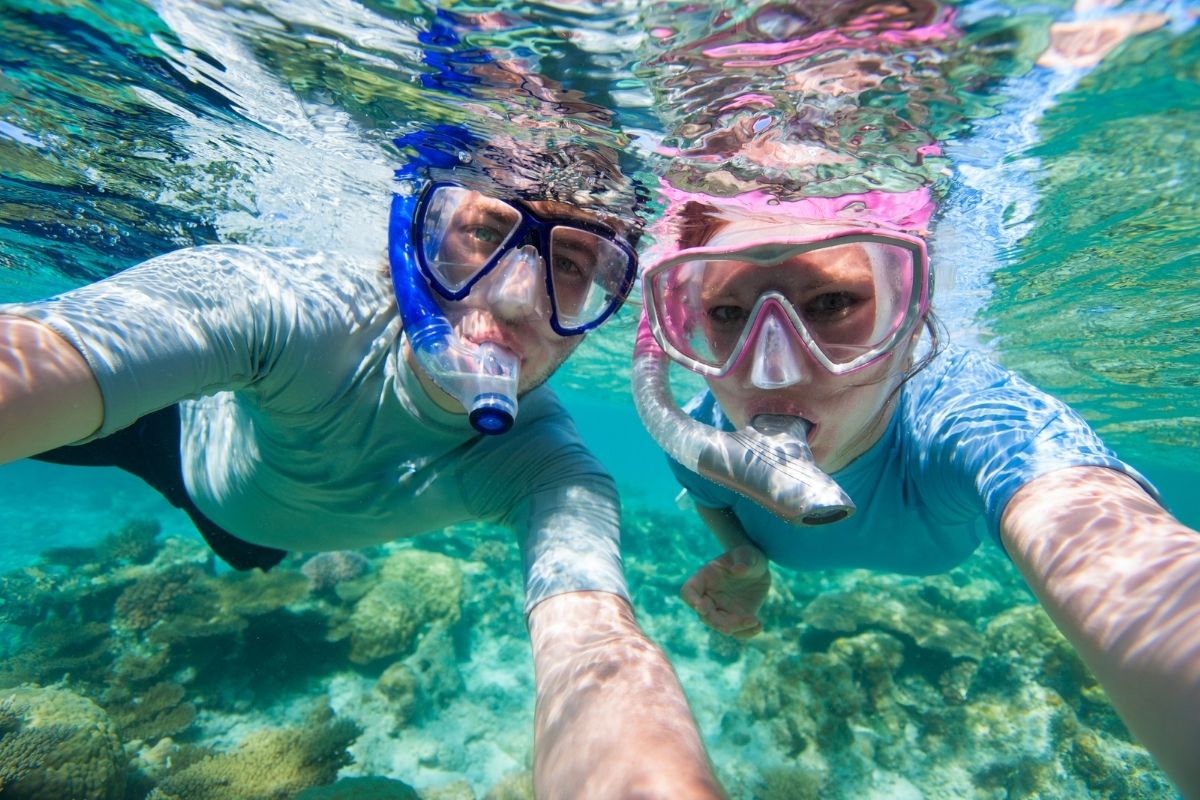12 Best Caribbean Islands for Snorkeling
When it comes to a tropical escape, it’s hard to beat the Caribbean with its more than 700 islands, reefs and cays. It’s the quintessential island vacation, with lazy days spent soaking up the sun and a gentle sea breeze, perhaps with a rum punch in hand. But many not only have postcard-perfect beaches with swaying palms to relax on, they also boast pristine coral reefs and warm, clear shallow waters just offshore.
If snorkeling among a myriad of colorful fish and all sorts of other marine life is what you’ve been dreaming of, these are the best Caribbean islands for your next escape.
Little Cayman, Grand Cayman Islands
The smallest island in the Cayman Islands, Little Cayman is only a mile wide and 10 miles long, but it’s one of the world’s premier snorkeling locations. While most visitors head to Grand Cayman to experience famous Stingray City, if you stay here, you’ll enjoy an especially tranquil retreat where the population is under 200 and there is little development.
The waters at Bloody Bay Marine Park are protected and feature what’s widely regarded as the best drop-off in the Caribbean.
You’ll have the rare chance to swim right over a coral cliff and experience a dream-like undersea world that’s teeming with life, including exotic fish, hawksbill turtles, and walls with gigantic barrel sponges, rope sponges, and webs of soft corals.
Virgin Gorda, British Virgin Islands
The British Virgin Islands are an archipelago of small islands that each have their own unique vibe and topography, including Virgin Gorda. It’s best-known for The Baths National Park which sits along the southwest coast.
Unlike anything else you’ll find in the Caribbean, it’s a remarkable collection of huge granite boulders, some as large as 40 feet in diameter, with “secret” rock pools and unspoiled white sandy beaches. The pools and grottoes that are formed by the boulders make it the region’s most photographed spot.
By following the rocky trail to Devil’s Bay, snorkelers will discover an underwater paradise. At the caves on the south side, you can marvel at multi-colored sponges and cup corals in relatively shallow depths of 12 to 15 feet. Trumpetfish, blue tangs, puffers, squid, sea horses, and more all inhabit the strikingly clear waters.
Dominica
The small island of Dominica is more well-known for its geothermal landscapes with hot springs and even boiling lakes, but just offshore, subterranean geothermal activity pushes through tiny cracks along the seafloor.
They fill the water with little warm bubbles which gave Champagne Reef its name. As you snorkel here, you’ll be among vibrant gardens of both soft and hard coral, along with parrotfish, frogfish, seahorses, and much more.
But the best part is that you might find yourself swimming next to a whale, especially if you’re in the deeper water which is inhabited by nearly 200 resident sperm whales that are here all year-round.
Fajardo, Puerto Rico
If you visit Puerto Rico, you want to spend time in Fajardo, located in the eastern region. It’s famous for the rare phenomenon of bioluminescence that can be experienced during a nighttime kayaking tour of the bay in Laguna Grande Nature Reserve.
After dark, the water emits an other-worldly glow that emanates from the over 700,000 half-animal, half-plant microorganisms here.
And just a 20-minute boat ride from here, you can snorkel in Cayo Diablo National Park. It straddles the Caribbean and Atlantic, drawing many to enjoy close encounters with green sea turtles and hawksbill turtles. While they’re the star of the show, the uncrowded cruising grounds and undisturbed reefs are also home to elkhorn and staghorn corals.
Tobago Cays, St. Vincent and the Grenadines
Located in the West Indies, the Tobago Cays Marine Park is made up of one inhabited island and five small, uninhabited cays. This is the kind of place you probably wouldn’t mind being stranded for a while, with the aquamarine water home to eagle rays, nurse sharks, and green turtles.
Protected by Horseshoe Reef and its kaleidoscope of colors, this beloved area has continued to thrive, with many tropical fish that can be seen swimming around in fairly shallow water, just five- to 12-feet deep. The grassy area that’s just off Baradel beach is the best place for snorkeling with turtles.
St. John, U.S. Virgin Islands
The smallest of the three U.S. Virgin Islands, St. John is home to what’s often named among the world’s most beautiful beaches, Trunk Bay. It’s one you’ve probably seen many times on Instagram, viral images, and travel sites luring visitors here.
The sand is pristine and pearly, stunningly contrasted against the turquoise sea. From here you can access the famous 650-foot-long Underwater Trail, a snorkeling path with diverse coral and colorful fish. Many fish can be seen from the surface due to the outstanding visibility.
This is the perfect place for kids and other beginners to learn to snorkel in water with a depth of less than 20 feet. Be sure to keep an eye out for the indigo-blue tunicates, a highlight here and a rather rare treat.
Silver Bank, Dominican Republic
For one of the best opportunities to snorkel with humpback whales, you’ll want to join a boat trip to Silver Bank. It’s not easy to reach, but this remote bank some 90 miles north of the Dominican Republic is one of the world’s top spots to swim with North Atlantic humpbacks.
It’s part of a larger preserve known as the Sanctuary of the Marine Mammals of the Dominican Republic and covers a massive, 40,000+ square miles.
Thanks to the shallow coral heads that lie along its northeastern boundary, the sea stays protected here and serves as the perfect grounds for breeding and calving. Underwater, you can hear the songs of the whales, and if you’re lucky, one of the curious mothers and calves might come over to see their human visitors.
Negril, Jamaica
Negril is the best place to base yourself for snorkeling in Jamaica. While a boat trip is the best option as the fringing reef is about 10 to 20 minutes offshore, there are some beaches where you can step right from the sand to snorkel too.
Bloody Bay has the same soft white sandy beach as famous Seven Mile Beach, but much better snorkeling. The water is warm and crystal-clear so you can easily spot the diverse sea life, making it ideal for families with children.
If you want a more secluded spot, take a boat to Booby Cay, a small island just offshore that gets its name from the many booby birds that live here. The snorkeling is fantastic, with thriving coral reefs inhabited by thousands of marine creatures.

Belize
The world’s second-largest barrier reef is the Mesoamerican Reef which lies off the coasts of Belize, Honduras, Guatemala, and Mexico in the Caribbean Sea.
It’s 700 miles long, following the entire shoreline of Belize, providing unrivaled coral reef snorkeling in clear turquoise waters that surround the cays. You’ll be mesmerized by the clarity and the color along with the abundance of colorful fish.
There are also sea turtles, whale sharks, and West Indian manatees. Glover’s Reef Atoll is one of the top spots, and a UNESCO World Heritage Site while Shark Alley is the best place to encounter rays and sharks.
Andros Island, Bahamas
The cobalt blue waters along the eastern edge of Andros offer the chance to snorkel the third largest barrier reef on Earth. The Andros Barrier Reef stretches for 124 miles and lies about two miles off the coast.
There are more than 100 miles of healthy coral formations between the island and deep water, much of it located in shallow water. There are mangrove areas, vast vertical cliff drops, and ocean trenches all inhabited by a high concentration of marine life, including octopus, barracuda, and tiger sharks.
Roatan, Honduras
Roatan is the largest of the Bay Islands in Honduras, renowned for its diving and snorkeling opportunities. You’ll find some of the very best off the shores of the tiny, uninhabited island of Pigeon Cay.
A 45-minute boat trip from Roatan, it’s postcard-perfect and includes a gorgeous white sandy beach with coconut trees for shade.
There’s a reef that starts just 15 to 20 feet from the sand and it surrounds the entire cay. Leap into the enticing, surreal blue waters to discover everything from iridescent damsels to parrotfish and Elkhorn coral.
Providenciales, Turks and Caicos
Turks and Caicos is home to some of the most beautiful powdery white sands you’ll ever see and Providenciales offers snorkeling right from the beach.
Bight Reef at Coral Gardens is easily accessible, with Penn’s Road leading to a footpath that leads directly to the start of the reef.
Fish sightings include parrotfish, barracuda, queen angelfish, yellowtail snapper, damselfish, yellow goatfish, butterflyfish, and so much more. Plus, when you’re done, you can relax among some of the most jaw-dropping scenery you’ve ever laid eyes on.
